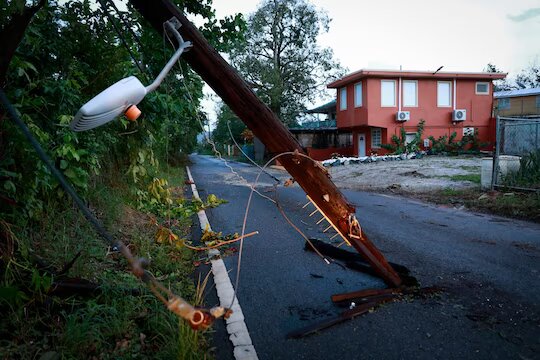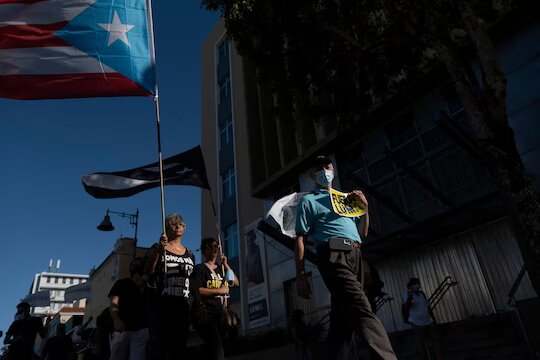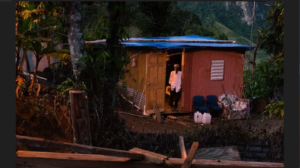WASHINGTON — A coalition of advocacy groups is suing the federal government’s disaster response agency, claiming it is making Puerto Rico less resilient to storms and more vulnerable to power outages by rebuilding the island’s old, unreliable power grid without properly assessing the environmental impacts or considering residents’ desire for renewable energy.
Nine environmental and community organizations filed a lawsuit Tuesday alleging that the Federal Emergency Management Agency (FEMA) is improperly using billions of dollars in congressionally appropriated disaster recovery funds to repair the fossil fuel-based grid without comprehensively examining the toll that it would take on residents, animals and the environment. The money is supposed to be “used to minimize greenhouse gas emissions and support initiatives in Puerto Rico that focus on mitigation, adaptation, and resilience, according to the White House. However, the suit argues, FEMA is doing the opposite by restoring harmful infrastructure and not considering “reasonable alternatives” like rooftop solar, which is cheaper and more widely distributed, and can better endure intense storms.

Continuing to fund the hurricane-battered grid is an environmental justice issue because residents with lower incomes and health problems bear the brunt of the impacts. Most of Puerto Rico’s coal- and gas-burning plants, which cause health issues like cancer, are disproportionately located in impoverished communities. And it is these residents who are also disproportionately affected by frequent, extensive blackouts due to the system’s poor infrastructure.
FEMA’s failure to consider other renewable energy options also makes these residents more susceptible to climate change because it robs Puerto Rico of an opportunity to become more disaster-resilient, the suit said, directly contradicting the agency’s purpose and mission — and the territory’s goal to use 100 percent renewable energy by 2050.

“FEMA has no business committing billions of dollars to a dirty, unreliable, centralized fossil fuel-based grid that’s guaranteed to plunge families back into the dark the next time a climate-driven storm hits,” said Augusta Wilson, a senior attorney at the Center for Biological Diversity, which is part of the lawsuit. “FEMA is recklessly ignoring Puerto Ricans and the climate emergency to enrich colonizing fossil fuel companies.”
FEMA said it does not comment on active litigation. However, in a January letter to the coalition obtained by The Washington Post, the disaster agency said it was repairing the old infrastructure to “address Puerto Rico’s immediate needs to provide its citizens with access to electricity and with critical services such as police protection, hospital care, and fire emergency response that depend on electricity to deliver their services.” FEMA said it was still committed to increasing Puerto Rico’s resilience and assisting its transition to renewable energy.
The lawsuit is the latest development involving Puerto Rico’s power grid, whose history of corruption, unreliability and failures has been well-documented in congressional hearings and first-person accounts. The grid failed to modernize after catastrophic hurricanes in 2017 that left the island in the dark for nearly a year. Officials promised to fix the system, but residential customers still pay nearly double what other Americans do for service. Last fall Hurricane Fiona knocked out power for hundreds of thousands of Puerto Ricans for weeks, further highlighting the island’s vulnerability to storms that are getting more intense due to climate change.
Meanwhile, the federal government has taken more than five years to start critically needed restoration projects to fix infrastructure and make the island more resilient to climate change, despite having set aside $65.7 billion in relief money for the 2017 hurricanes. The suit alleges that FEMA is using a portion of those funds to further stymie progress by keeping residents, many of whom can barely afford their electricity bills, at risk for blackouts.
FEMA plans to use about $13 billion for two power-grid restoration projects. For major initiatives like this, the National Environmental Policy Act (known as NEPA) obligates federal agencies to consider “every significant aspect of the environmental impact of the proposed action,” outline the adverse effects and make all of this available to the public through an environmental-impact statement. The lawsuit alleges that FEMA bypassed this last, critical step, despite public feedback flagging concerns and flaws with the projects. FEMA did not adequately respond to the comments, nor did it explain why it disregarded them. Instead, in 2021 and 2022, the agency reported that the projects would not significantly harm the environment, in what is known as a “Finding of No Significant Impact.”
In response to allegations that it did not follow the federal law, FEMA said in the January letter that it viewed the projects’ environmental assessments “as a start to a more comprehensive NEPA analysis.”
The complaint says that the projects do not mention climate change, despite Puerto Rico being at risk. The Environmental Protection Agency said in 2016 that the water surrounding the island has warmed 2 degrees since 1901 and the island has warmed 1 degree since the mid-20th century. FEMA is choosing to “invest billions of dollars in rebuilding, relocating, and perpetuating Puerto Rico’s centralized, fossil fuel-based electricity grid,” the complaint states.
“This is a historic amount of money, and it presents a once-in-a-lifetime opportunity for us to try to break this vicious cycle of storms coming in and destroying our infrastructure,” said Ruth Santiago, an environmental lawyer in Puerto Rico and part of the coalition. “FEMA is supposed to be implementing resiliency. We can’t let the government just dole out this money and take us back to where we were before.”
Puerto Rico has been plagued by a poverty rate of nearly 44 percent and a graying of the island that’s been accelerated by a series of major disasters, which further hurt the economy and forced younger, working-age adults elsewhere. More than 1 in 5 people are over 65, a rate on par with some of the world’s grayest nations. This segment of the population is also the most vulnerable when the power goes. They are usually on fixed incomes, have health issues and need medications, like insulin, that need to be refrigerated.
These vulnerable residents are frequently without power for days and even weeks when it rains, they said. The island’s grid is complex and vulnerable because it generates most of its power from a collection of plants mostly in the southern part of the island that then transmits high-voltage electricity using poles and lines along a mountain range dense with tropical forests to the more populated north, where the majority of the demand is. So when strong winds and rains pummel the island, as they so often do, and knock down a part of this distribution system, it’s difficult and cumbersome to get it back online.
Residents who live in towns near the polluting plants describe concerning fires and startling explosions. Coal ash has been contaminating their groundwater, killing their fish and giving their neighbors cancers, bone ailments, respiratory problems and miscarriages that have been plaguing their communities, Santiago and other residents said.
Hery Colon lives in Salinas and has spent his entire 28 years next to a power plant he called “the monster” in an interview with The Washington Post with the help of a translator. Last year, the EPA reported that another part of the town, near a medical-equipment sterilization company, had extremely high concentrations of ethylene oxide, which causes cancer.
He said he believes that if his community had the money to pay for “health testing,” the power complex would have been closed a long time ago. Most people around him have allergies and trouble breathing, he said, and when there are spills, an overwhelming “petro smell” permeates the town. The diversity of their fish has plummeted. The booming, spontaneous noises that shake his home two doors down from the power plant’s fence still make him cry sometimes, he said.
Like other residents, Colon said it was hard to find information from FEMA about its plans to repair parts of the plant so he could share his thoughts. He is a part of Comité Dialogo Ambiental, one of the groups suing FEMA. The information has not been accessible or easy to get for his community, he said, describing not “knowing what is happening around us” as a “class issue.”
As he looks out his window, he said, the loud whirring of the machines sucking in seawater and the emissions filtering out from the wide stacks make him angry.
“Living so close to the problem, I would hope that people making the decisions would put themselves in our positions,” he said. “Not depending on these plants to survive is a great step forward to having a better life, where we have self-governance by our community.”
By BRIANNA SACKS/Washington Post

